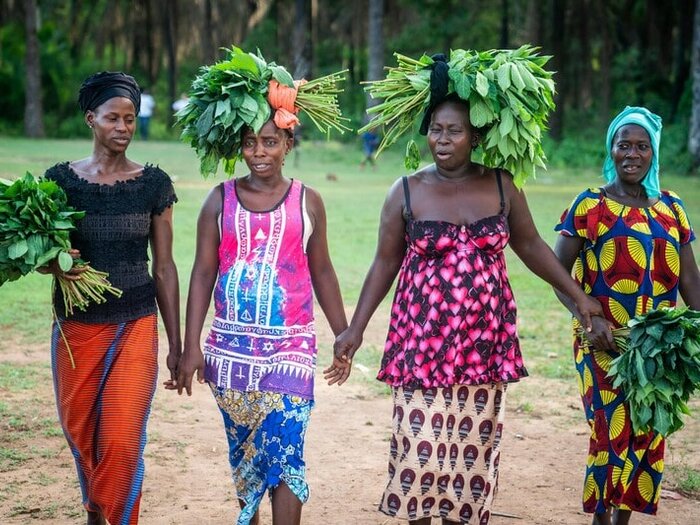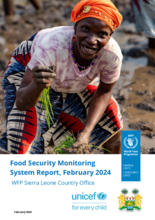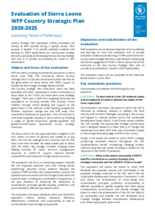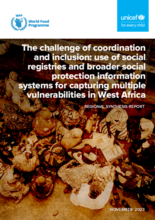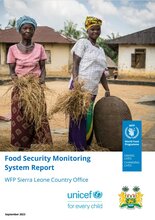Sierra Leone
- 57%
- of people are food insecure
- 26.2%
- children stunted (impaired growth and development due to chronic malnutrition)
- 216,000
- children receiving school meals each day
Sierra Leone is a small but densely populated country on the North Atlantic coast of West Africa, ranked 182 out of 189 countries in the 2020 Human Development Index.
The country had been recovering from an 11-year war, which destroyed infrastructure and basic social services, when it was hit by an Ebola outbreak in 2014. The disease claimed 4,000 lives.
The COVID-19 pandemic devastated Sierra Leone’s economy, slowing growth and the rate of poverty reduction. Growth contracted to –2 percent in 2020, mainly due to a shutdown of the service sectors, and reduced manufacturing, construction and agriculture.
Economic growth rebounded by 2.9 percent in 2021, before the effects of the war in Ukraine reversed these gains. In July alone, the price of fuel rose by 120 percent and, even though the Government later brought it down, the cost of living continues to rise.
What the World Food Programme is doing in Sierra Leone
-
Emergency response
-
WFP assists the most food-insecure populations, in collaboration with the Ministry of Social Welfare. Cash transfers empower people to make their own choices of food, including fresh vegetables and fruit, while boosting the local economy. Strengthening the emergency-response capacity of the National Disaster Management Agency is also a WFP priority. In 2021, WFP embedded an international climate change specialist to assist the agency with technical and operational support.
-
Home-grown school feeding
-
In supporting the Government’s efforts to draw children to school, WFP provides daily hot meals to 216,000 pupils in the most food-insecure areas. For some schools, WFP obtains part of this food from local smallholder farmers’ groups, as it gradually scales up home-grown school feeding in line with the national policy. More children are being served fresh vegetables each day, and the farmers have a reliable market for their crops. WFP also trains cooks to prepare safer, tastier and more nutritious food.
-
Mother-and-child nutrition
-
Inadequate knowledge around complementary feeding – when food other than milk is added to the diet – is a key driver of stunting in children aged 6-23 months. WFP helps mother-support groups to conduct regular community sensitization and cooking demonstrations. The exercises target pregnant and breastfeeding women and adolescent girls in three districts, who are educated and counselled about the best complementary feeding practices. WFP also supports local research by introducing local species of enriched complementary foods.
-
Promoting local nutritious foods and supporting applied research
-
WFP works with Sierra Leone Agricultural Research Institute to promote diet diversity and people's access to healthy local foods for their infants. Following successful acceptability trials, WFP and the institute have introduced four standardized and enriched local complementary foods. These include tubers rich in pro-vitamin A, such as orange fleshed sweet potato and yellow cassava. WFP supports communities in cultivating and storing them safely.
-
Supporting smallholder farmers
-
WFP assists 140 groups – comprising over 9,000 smallholder farmers across seven districts – to cultivate, process and market rice and nutritious vegetables. The groups cultivate inland valley swamps, a high-production source that can be farmed year-round. WFP supports the farmers in irrigation schemes. The smallholders are also trained in climate-smart agricultural methods, post-harvest crop management, group marketing and how to successfully run village savings and loans schemes. The farmers’ groups supply the home-grown school feeding programme.
-
Strengthening livelihoods for peace at Guinea border
-
To strengthen peace between Sierra Leone and Guinea, WFP is working with the International Organization for Migration to implement a cross-border UN peacebuilding project. The partners are working to minimize localized conflicts between cattle keepers and crop farmers in Falaba district in Sierra Leone and Faranah prefecture in Guinea. WFP supports all-year climate-sensitive agriculture, by cultivating inland valley swamps. This draws people away from the slash-and-burn farming in the uplands, which is associated with tree-cutting, reduced soil fertility and low yields. At the same time, it supports reforestation.
Sierra Leone news releases
Go to pagePartners and donors
Find out more about the state of food security in Sierra Leone
Visit the food security analysis pageOperations in Sierra Leone
Contacts
Office
6A Renner Drive Off Wilkinson Road P. O. Box 1011
Freetown
Sierra Leone

